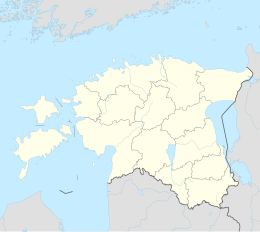Põlva (Põlva)
| Põlva | ||
| State : |
|
|
| Circle : |
|
|
| Coordinates : | 58 ° 3 ' N , 27 ° 3' E | |
| Time zone : | EET (UTC + 2) | |
|
|
||
Põlva ( German Pölwe or Pölwa ) is the capital of the municipality of Põlva and thus the capital of the Põlva district . It is located in the south of Estonia .
geography
Põlva is located on the lower reaches of the Orajõgi River , a glacial valley in the Baltic region . The city is located about 25 km from Võru and 50 km from Tartu . It has been part of the Põlva municipality since 2013 .
history
The place was first mentioned in a document at the beginning of the 13th century. The name is said to come from the Estonian word for knee (põlv), without the origin being clearly clarified. Allegedly a kneeling sinner was walled up in the church! Hence the relation to the knee. This information is based on narratives. Põlva was the waypoint of an old military route between the north and south of Livonia.
Around 1240, shortly after Estonia was Christianized , monks of the St. Bernard Order built a church which they consecrated to the Virgin Mary . The name Põlva was first mentioned in 1452 . The church village was under the bishop of Tartu .
The parish of the same name came under Russian rule in the 16th century as a result of the Livonian War . In 1582, like all of southern Estonia, it came under Polish sovereignty, later it belonged to Sweden . In the Peace of Nystad in 1721 , Estonia and Livonia were ceded to Russia.
It was only with Estonia's state independence in 1918 that Põlva gained supraregional importance. The population grew rapidly. In 1931 the railway line from Tartu via Põlva to Saint Petersburg was completed. After that, textile and dyeing companies in particular settled in Põlva.
On August 10, 1993, Põlva was granted city rights. Sister city is the Swedish Vårgårda in Västergötland .
In October 2013, the city of Põlva and the surrounding rural community were merged.
Attractions
The St. Mary's Church in Põlva is worth seeing. The three-aisled hall church was built between the 13th and 14th centuries. It was changed a lot around 1645. The high tower with its red helmet dates from 1460. The first bell of the church was cast in Stockholm in 1648 , and another in Bochum in 1868 . A commemorative plaque for the Estonian theologian and folklorist Jakob Hurt (1755–1838) is attached to the church.
Pastor of Põlva was from 1781 to 1819 the founder of Estonian journalism, Gustav Adolph Oldekop (1755-1838). The same office was held in Põlva from 1820 to 1874 by Johann Georg Schwartz (1793–1874), one of the most important Estonian educators of the 19th century.
The first Estonian song festivals were held in the Intsikurmu Forest Park between 1855 and 1857 . Sometimes over 3500 people took part.
Personalities
- Georgi von Stackelberg (1851–1913), Russian general of the cavalry
- Diana Leesalu (* 1982), author
- Mait Patrail (* 1988), handball player
- Signy Aarna (* 1990), soccer player
- Eneli Vals (* 1991), soccer player
- Maicel Uibo (* 1992), decathlete
Web links
- Tourism in Põlvamaa (Estonian, German, English, Russian)
- Põlva Cultural Center (Estonian)
- Põlva Lutheran Marian Congregation (Estonian)

